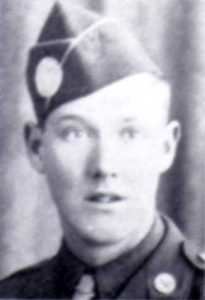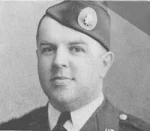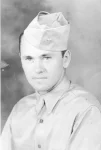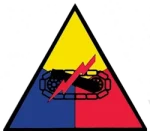Pvt. Raymond Ward born in Universal, Indiana, on October 8, 1922, to Elijah P. Ward and Rose Wright-Ward who had immigrated to the United States from England. With his three sisters and five brothers, he lived at 409 South 10th Avenue, Maywood, Illinois, and he was a 1940 graduate of Proviso Township High School. After high school he worked at the Jefferson Electric Company, Bellwood, Illinois.
Raymond registered with Selective Service, on August 25, 1942, and named his father as his contact person. Knowing he was going to be drafted into the army, he enlisted on August 25, 1942, and received the serial number 16 101 178. Because of his score on the Army General Classification Test, and his civilian work skills, he was given the opportunity to join the paratroopers which had been formed on August 16, 1942. It is known he trained at Camp Wolters, Texas, Fort Benning, Georgia, and Ft. Brag, North Carolina, as a member of Company C, 506th Parachute Infantry Regiment, 101st Airborne Division
The 101st arrived in England on September 15, 1943, and trained in Berkshire and Wiltshire. The night of June 5, 1944, the division was dropped into France behind Utah Beach securing strategic locations to prevent the Germans from reinforcing the Normandy beaches. After completing their objectives, the 101st and the 82nd Airborne Division were given the job of capturing Carentan the largest town in the area. By taking the town German communication with the beaches and ability to reinforce its troops would be stopped. To do this, the 101st had to capture Saint-Come-du-Mont first. The fight for the town started on June 8th after the Germans held up the 101st for two days. The battalion fought for sixty hours without rest. The Americans took the town on the 9th.
The Battle of Carentan started on in the early morning hours of the June 10th against two battalions German 6th Parachute Regiment. The casualties among the Americans were high. The next day when the fighting continued it was hand-to-hand for six hours. At noon on the 11th, a truce was negotiated to collect the wounded and dead. The German commander had been ordered by Hitler not to surrender. When the Germans ran out of ammunition they began to withdraw from the town. According to Raymond’s family, he was hit by enemy fire and killed, on June 15, 1944, while defending a bridge over the Douve River at Carentan on the 12th. He was buried on June 17, 1944, at United States Military Cemetery #1, Ste Mere Eglise, in Plot C, Row 9, Grave 178.
MRS ROSE WARD
409 SOUTH 10TH AVENUE
MAYWOOD ILLINOIS
THE SECRETARY OF WAR DESIRES ME TO EXPRESS HIS DEEP REGRET THAT YOUR SON PRIVATE RAYMOND WARD HAS BEEN REPORTED MISSING IN ACTION SINCE TWELVE JUNE IN EUROPEAN AREA PERIOD IF FURTHER DETAILS OR OTHER INFORMATION ARE RECEIVED YOU WILL BE PROMPTLY NOTIED PERIOD
ULIO
THE ADJUTANT GENERAL
A letter followed the telegram.
Mrs. Rose Ward
409 South 10th Avenue
Maywood, Illinois
Dear Mrs. Ward:
This letter is to confirm my recent telegram in which you were regretfully informed that your son, Private Raymond Ward., 16 101 178, Airborne, has been reported missing in action since 12 June 1944 in France.
I know that added distress is caused by failure to receive some information or details. Therefore, I wish to assure you that at any time additional information is received it will be transmitted to you without delay, and, if in the meantime no additional information is received, I will again communicate with you at the expiration of three months. Also, it is the policy of the Commanding General of the Army Air Forces upon receipt of the “Missing Air Crews Report” to convey to you any details that might be contained in that report.
The term “missing in action” is used only to indicate that the whereabouts or status of an individual is not immediately known. It is not intended to convey the impression that the case in closed. I wish to emphasize that every effort is exerted continuously to clear up the status of our personnel. Under war conditions this is a difficult task as you must readily realize. Experience has shown that many persons reported missing in action are subsequently reported prisoners of war, but as this information is furnished by countries with which we are at war, the War Department is helpless to expedite such reports. However, in order to relieve financial worry, Congress has enacted legislation which contains in force pay, allowances and allotments to dependents of the personnel being carried in a missing status.
Permit me to extend to you my heartfelt sympathy during this period of uncertainty.
Sincerely yours,
(signed)
J. A. ULIO
Major General
The Adjutant General.
When his death was confirmed, his status as missing in action was terminated and his mother received another telegram on July 20, 1944.
MRS ROSE WARD
409 SOUTH 10TH AVENUE
MAYWOOD ILLINOIS
THE SECRETARY OF WAR ASKS THAT I ASSURE YOU OF HIS DEEP SYMPATHY IN THE LOSS OF YOUR SON PRIVATE RAYMOND WARD WHO WAS PREVIOUSLY REPORTED MISSING IN ACTION REPORT NOW RECEIVED STATES HE WAS KILLED IN ACTION TWELVE JUNE IN FRANCE CONFIRMING LETTER FOLLOWS=
J A ULIO TTHE ADJUTANT GENERAL
His mother next received a letter from the War Department.
Mrs. Rose Ward
409 South 10th Avenue
Maywood, Illinois
Dear Mrs. Ward:
It is with profound regret that I confirm the recent telegrams informing you of the death of your son, Private Raymond Ward, 16 101 178, Airborne, who was previously reported missing in action on 12 June 1944 in France.
An official message has now been received which states that he was killed in action on the date he was previously reported missing in action. Recently, provisions were made whereby there will be sent directly to the emergency addressee or the next of kin a letter containing further information about each person who dies overseas in the service of our country, and if this letter has not already been received, it may be expected soon.
I realize the burden of anxiety that has been yours since he was first reported missing in action and deeply regret the sorrow this later report brings you. May the knowledge that he made the supreme sacrifice for his home and country be a source of sustaining comfort.
My sympathy is with you in this time of great sorrow.
Sincerely yours,
(signed)
J. A. ULIO
Major General
The Adjutant General.
Since Raymond was dead, his father was now his next-of-kin. In a letter dated April 16, 1947, his father was told where Raymond was buried and his location in the cemetery. He was also informed that the War Department expected to receive authorization to return the dead home. When it had the authority, he would receive another letter telling him of his options for Raymond’s final burial. The letter dated September 19, 1947, arrived and he was asked to complete an enclosed form indicating where he wanted Raymond buried and to return it to the Office of the Quartermaster General Office, Washington DC. The OQMG received the form on October 21, 1947, and it indicated that his father wanted Raymond buried at an American Military Cemetery overseas.
On April 15, 1948, Raymond was exhumed from Cemetery #1, Ste-Mere-Eglise and taken by truck to Casketing Point B, Ste Laurent, France, and casketed. His remains remained there until February 18, 1949. On that day, with full military honors, Pvt. Raymond Ward was buried in Plot E, Row 12, Grave 19, at the Normandy American Cemetery, Colleville-Sur-Mer, France. His father was sent the flag that covered his casket with a letter.
Pvt Raymond Ward, ASN 16 101 178
Plot E, Row 12, Grave 19
Headstone: Cross
St. Laurent (France) U. S. Military Cemetery
Mr. Elijah P. Ward
409 South 19th Avenue
Maywood, Illinois
Dear Mr. Ward:
This is to inform you that the remains of your beloved one have been permanently interred, as the recorded above, side by side with comrades who also gave their lives for their country. Customary military funeral services were conducted over the grave at the time of burial.
After the Department of the Army has completed all final interments, the cemetery will be transferred, as authorized by the Congress, to the care and supervision of the American Battle Monuments Commission. The commission will have the responsibility for permanent construction and beautification of the cemetery, including erection of the permanent headstone. The headstone will be inscribe with the name exactly recorded above, the rank or rating where appropriate, organization, State, and date of death. Any inquiries relative to the type of headstone or the spelling of the name to be inscribed thereon, should be addressed to the American Battle Monuments Commission, the central address of which is 1712 “G” Street, N. W. Washington 25, D. C. Your letter should include the full name, rank, serial number, grave location, and name of the cemetery.
While interments and beautification activities are in progress, the cemetery will not be open to visitors. You may be rest assured that this final interment was conducted with fitting dignity and solemnity and that the grave-site will be care-fully and conscientiously maintained in perpetuity by the United States Government.
Sincerely yours,
(signed)
W. FELDMAN
Major General
The Quartermaster General







